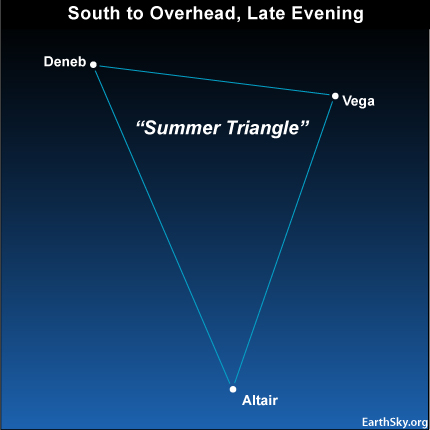Summer Triangle on August Evenings
Posted by Bruce McClure in TONIGHT | August 17, 2019
We’ve recently seen Orion’s return to the east before dawn, which means our northern summer is beginning to draw to a close. But the Summer Triangle asterism still rules the skies. It pops out first thing at nightfall and climbs highest up for the night at late evening. From mid-northern latitudes, Vega – the Summer Triangle’s brightest star – shines high overhead around 10 p.m. local daylight saving time (9 p.m. local standard time). Altair resides to the southeast (lower left) of Vega, and Deneb lies to Vega’s east (left).
The Summer Triangle is not a constellation. It is three bright stars in three different constellations, as the wonderful photo below – by Susan Jensen in Odessa, Washington – shows.
As the stars drift westward during the night, Deneb will swing upward to replace Vega as the overhead star some two hours later. Of course, the stars aren’t really moving. It’s the Earth’s rotation that causes the stars to move westward during the night, and the sun to go westward during the day.
Because the three stars making up the Summer Triangle are 1st-magnitude stars, you can easily see the brilliant Summer Triangle on moonlit nights. However, you need a dark sky free of moonlight to see the great swath of stars known as the Milky Way passing in between the Summer Triangle stars Vega and Altair. The star Deneb bobs in the middle of this river of stars that meanders through the Summer Triangle, arcing across the sky from horizon to horizon. Although every star that you see with the unaided eye is actually a member of our Milky Way galaxy, the term Milky Way often refers to the cross-sectional view of the galactic disk, whereby innumerable far-off suns congregate into a cloudy trail of stars.
Make friends with the Summer Triangle and its three brilliant stars – Vega, Deneb and Altair – tonight. Note the great boulevard of stars that streams right through the Summer Triangle on an inky-dark night. That’s actually an edgewise view into the flat disk of our Milky Way galaxy.
By the way, you can see the Summer Triangle in the Southern Hemisphere, too – although there do you call it the Winter Triangle? I wonder. South of the equator, people see an upside-down version of tonight’s sky scene, in contrast to our northern perspective. Late tonight, Southern Hemisphere residents will see Altair at the top of the Summer Triangle, and Vega and Deneb sparkling at the bottom.
 |
 |
|
|||||||||||
 |
 |
||||||||||||
|
|
|
|
|
|
|
||||||||
 |
|
|
|
|
|
 |
|||||||
|
|
|
|
|||||||||||
|
|
|||||||||||||
|
|
|
|
|
|
|
|
|
|
|
|
|
|
|
Results 1 to 1 of 1
Thread: Summer Triangle
-
08-21-2019, 08:10 PM #1
Summer Triangle
Beginner's Guide for Rocket, NFPS and IKS66...
http://iptvtalk.net/showthread.php?2...-you-should-do
Kodi Options for Rocket, NFPS and IKS66...
http://iptvtalk.net/forumdisplay.php?71-Kodi
Check the Announcement Section...
http://iptvtalk.net/forumdisplay.php...-Announcements
Similar Threads
-
Died this summer at the age of 194 years
By crazed 9.6 in forum World NewsReplies: 3Last Post: 08-30-2020, 03:41 AM -
Summer Triangle in northern autumn
By ilan in forum Maps to the StarsReplies: 0Last Post: 11-26-2019, 01:40 PM -
Massive black triangle UFO over New Lambton Heights in 1999
By ilan in forum ExtraterrestrialReplies: 0Last Post: 02-23-2019, 01:44 PM -
In the Summer Time !!!
By crazed 9.6 in forum MusicReplies: 4Last Post: 05-13-2017, 06:57 PM -
wwe summer slam
By dan2015 in forum IPTV Private Server (NFPS)Replies: 4Last Post: 08-23-2015, 08:24 PM








 Reply With Quote
Reply With Quote